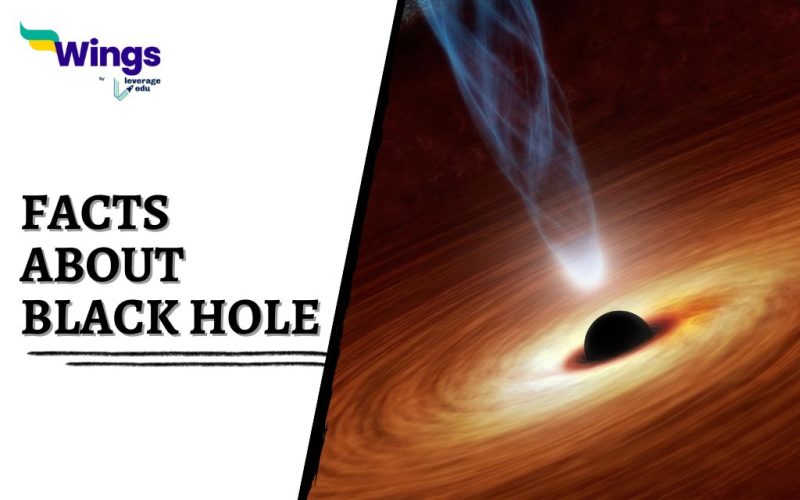Black Holes are among the most mysterious and fascinating cosmic objects in the universe. One of the many scary facts about space, specifically black holes, is that they are regions of space where gravity is so strong that nothing, not even light, can escape. This makes them incredibly difficult to observe directly. There are several types of black holes, and we will learn about all of them in this blog, along with many more things about the cosmic area through facts about Black Holes. So, let’s get started.
Table of Contents [show]
10 Fun Facts about Black Hole
Ever wondered about the most mysterious objects in the universe? This mysterious object is a Black Hole and to know about it read the facts about Black Hole mentioned below –
- Some supermassive black holes are so active that they emit immense amounts of energy, creating quasars — extremely luminous objects powered by black holes consuming matter at an extraordinary rate.
- Despite the name, Black Holes are not holes in Space.
- Ripples which are known as gravitational waves, are produced when the Black Hole collides.
- If a neutron star gathers enough additional mass, it can collapse into a black hole. This can happen when it pulls matter from a companion star.
- The shadow of a Black Hole forms an accretion disk, heating up to millions of degrees as it spirals.
- When two black holes merge, they produce a single, more massive black hole.
- Smaller Black Holes emit more Hawking radiation and have higher temperatures.
- The presence of a black hole significantly warps the fabric of spacetime around it, affecting the paths of nearby stars and gas clouds.
- Time slows down near a black hole.
Also Read – 23 Stellar Facts About Stars In Your Night Sky!
10 Black Hole Facts That You Should Know
Do you know how Black Hole form? Or what are the types of Black Hole? To get all your answers read the facts mentioned below –
- Black Hole forms when massive stars exhaust their fuel and collapse under their own gravity.
- The types of Black Holes are – Stellar Black Holes, Supermassive Black Holes, and Intermediate Black Holes.
- Astronomers cannot directly see Black Holes.
- In 1964 the first strong evidence of a black hole came from Cygnus X-1.
- Event Horizon is the boundary around the Black Hole.
- The Event Horizon Telescope collaboration released the first image of a black hole in 2019.
- If a star passes too close to the Black Hole to Earth, it is Gaia BH1, located approximately 1,560 light years away.
- Contrary to popular belief black holes don’t “suck” objects in like a vacuum cleaner.
- Hawking Radiation theory proposed by Physicist Stephen Hawking states that Black Holes can emit radiation due to quantum effects near the Event Horizon.
- Scientists aim to capture more images of black holes, including the supermassive black hole Sagittarius A* at the centre of our Milky Way, which is quieter than expected.
10 Facts about Black Hole – By NASA
NASA presents the latest discoveries and mind-bending facts about black holes which are listed below -.
- All black holes spin. The fastest-known – named GRS 1915+105 – clocks in at over 1,000 rotations per second.
- The most distant black hole detected, at the centre of a galaxy called QSO J0313-1806, is around 13 billion light-years away.
- The nearest known black hole, called Gaia BH1, is about 1,500 light-years away.
- The most massive black hole observed, TON 618, tips the scales at 66 billion times the Sun’s mass.
- Monster black holes at the centres of galaxies can launch particles to near light speed.
- The lightest-known black hole is only 3.8 times the Sun’s mass. It’s paired up with a star.
- A real term that describes what happens when matter gets too close to a black hole. It’s squeezed horizontally and stretched vertically, resembling a noodle.
- If you replaced the Sun with a black hole of the same mass, the solar system would get a lot colder, but the planets would stay in their orbits.
- Most Milky Way-sized galaxies have monster black holes at their centres. Our is called Sagittarius A* (pronounced ey-star), and it’s 4 million times the Sun’s mass.
- One type of black hole is born when massive stars run out of fuel and explode in supernovae.
Also Read – 20 Interesting Facts About Earth for Students
FAQs
Probably there is a Black Hole in the Milky Way, astronomers cannot directly see Black Holes, but in 1964 the first strong evidence of a black hole came from Cygnus X-1, event Horizon is the boundary around the Black Hole, the Event Horizon Telescope collaboration released the first image of a black hole in 2019.
Black holes are unique for their intense gravitational pull that prevents anything, even light, from escaping, creating phenomena like singularities and event horizons. They challenge our understanding of physics and are key to exploring concepts like dark matter and the formation of galaxies.
Near a black hole’s event horizon, 1 minute for you could equal hours, years, or even centuries for a distant observer, depending on the black hole’s mass and your proximity to it.
Relevant Reads
Hope you like reading these interesting facts about Black Hole. If you want to know more about topics like this, then visit our Interesting Facts and General Knowledge page!
 One app for all your study abroad needs
One app for all your study abroad needs















 45,000+ students trusted us with their dreams. Take the first step today!
45,000+ students trusted us with their dreams. Take the first step today!
